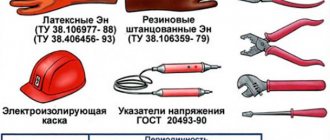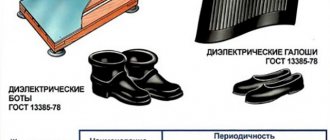Protective equipment in electrical installations
What refers to protective equipment in electrical installations?
Basic and additional means of protection up to 1000 V and above 1000 V.
Standards for completing PPE. Requirements for recording protective equipment.
***
PPE
Protective equipment is divided into 2 categories: collective and individual.
Protective equipment is classified into: 1. Insulating 2. Fencing 3. Devices for working at height 4. Auxiliary devices 5. Shielding.
Insulating protective equipment.
They provide electrical insulation of a person from live or grounded parts of electrical equipment, as well as from the ground.
All insulating protective equipment is divided into:
- Basic
- Additional
Basic insulating protective equipment - means whose insulation reliably withstands the operating voltage of electrical installations and with the help of which it is possible to touch live parts that are energized without the danger of electric shock.
Additional insulating protective equipment are those that, having insufficient insulation, cannot ensure the safety of the worker. They can only be used in combination with basic means, enhancing their effect.
In electrical installations up to 1000 V:
main insulating agents:
- dielectric gloves,
- insulating current clamps,
- assembly tool with insulated handles,
- current detectors.
additional insulating agents:
- dielectric galoshes
- rugs
- insulating stands
In electrical installations above 1000 V: the main insulating means:
- insulating rods
- insulating current clamp
- voltage indicators
additional insulating agents:
- assembly tool with insulated handles
- dielectric gloves
- bots
- rugs
- insulating stands
STANDARDS FOR PROTECTIVE EQUIPMENT
In accordance with Appendix No. 8 to the Instructions for the use and testing of protective equipment used in electrical installations SO 153-34.03.603-2003
| Switchgears with voltage up to 1000 V | ||
| Insulating rod (operational or universal) | According to local conditions | |
| Voltage indicator | 2 pcs. | |
| Insulating pliers | 1 PC. | |
| Dielectric gloves | Two pairs | |
| Dielectric galoshes | Two pairs | |
| Dielectric carpet or insulating pad | According to local conditions | |
| Safety barriers, isolation pads, portable posters and safety signs | Same | |
| Protective shields or glasses | 1 PC. | |
| Portable grounding | According to local conditions | |
| Switchgears with voltages above 1000 V | ||
| Insulating rod (operational or universal) | 2 pcs. for each voltage class | |
| Voltage indicator | Same | |
| Insulating pliers (in the absence of a universal rod) | 1 PC. for each voltage class (with appropriate fuses) | |
| Dielectric gloves | At least 2 pairs | |
| Dielectric boots (for outdoor switchgear) | 1 pair | |
| Portable grounding | At least 2 for each voltage class | |
| Protective fences (shields) | At least 2 pcs. | |
| Safety posters and signs (portable) | According to local conditions | |
| Insulating gas mask | 2 pcs. | |
| Protective shields or glasses | 2 pcs. | |
Requirements for protective equipment
All electrical protective equipment and personal protective equipment in use must be numbered, with the exception of protective helmets, dielectric carpets, insulating stands, safety posters, protective fences, and rods for transferring and potential equalization. Serial numbers may be used.
In departments of enterprises and organizations it is necessary to keep logs of records and maintenance of protective equipment. Personal protective equipment issued for individual use must also be recorded in a journal.
| Name | Periodicity | |
| examinations | tests | |
| Dielectric gloves | before use | Once every 6 months |
| Tool (for insulation) | before use | Once a year |
| Pointers (UNN) | before use | Once a year |
| Insulating pliers | Once a year | Once every 2 years |
Protective equipment that has passed the test, the use of which depends on the voltage of the electrical installation, is stamped with the following form:
| № _______ Suitable up to _____ kV Next test date “____” __________________ 20___ _________________________________________________________________________ (laboratory name) |
Protective equipment, the use of which does not depend on the voltage of the electrical installation (dielectric gloves, galoshes, boots, etc.), is stamped in the following form:
| № _______ Next test date “____” __________________ 20___ _________________________________________________________________________ (laboratory name) |
Check before use
Before each use, the electrician must make sure that the period of the next PPE test has not passed; this information is indicated on special stamps. In addition, an external inspection is mandatory, and if damage to the insulating coatings is detected, the products must be sent for extraordinary testing. Dielectric gloves are additionally checked for leaks by filling them with air and twisting them. If leaks are detected, use is unacceptable.
We pay attention to the correct selection of personal protective equipment depending on the conditions of use, compliance with the frequency and procedure for carrying out inspections or tests. Violations in these matters will cause electrical injuries, including death.
Frequency of inspections and tests
In accordance with current standards and rules, a clear frequency of testing and inspection has been defined for PPE used in work. Mandatory regularity of operational tests:
- Every six months, dielectric gloves are subjected to such a check.
- Every year it is necessary to test insulated hand tools, protective overshoes, measuring rods, including high-voltage voltage regulators.
- Every 2 years, current and insulating clamps and operating rods are checked.
- Dielectric boots must be tested at least once a year.
Condition monitoring and accounting of electrical protection equipment
For the most efficient and safe operation in electrical installations with voltages up to and above 1000 V, it is necessary to periodically monitor the condition of protective equipment, as well as their accounting. For this use:
- Numbering. With the exception of those SZ for which an inventory number is not necessary: helmets, carpets, stands, etc. (the use of factory markings as an inventory number is allowed), the order of which depends on the internal regulations of the individual enterprise and the operating conditions of the SZ.
- Logbooks for recording and maintaining personal and collective protective equipment. The readings and results of the SZ inspection are entered into them at least once every six months.
- Checking compliance of protective equipment received from the manufacturer's factory or warehouse with operational test standards (with the exception of dielectric stands, carpets, portable grounding, posters, etc.). Successful verification is confirmed by the appropriate stamp. In cases where the protective equipment has not passed the test, the stamp is crossed out with red paint.
Classification of electrical protective equipment
All of them are classified as follows:
- Insulating
- Fencing
- Equipment for working at height
- Accessories
- Shielding
The “model range” itself includes:
- insulating rods of all available types (operational, measuring, for applying grounding);
- insulating and electrical clamps;
- voltage indicators of all types and categories (with incandescent or gas-discharge lamps, non-contact, pulse, etc.);
- alarms for the presence of voltage in the area (non-contact);
- gloves, boots and galoshes with dielectric properties, carpets, insulating stands;
- protective fences (boards, screens, insulating linings, as well as caps);
- portable grounding;
- a number of devices and devices that ensure the safety of personnel during testing or measurements in electrical installations (voltage indicators for checking phase coincidence, products for cable puncture, equipment for determining voltage differences in transit, cable section damage indicators, etc.);
- posters, banners and safety signs;
- other protective equipment, insulating products and devices for carrying out repair work (maintenance) under voltage in electrical installations of 110 kV or more, as well as in electrical networks up to 1000 V (flexible and polymer insulators, dielectric (insulating) ladders or stepladders, ropes, inserts telescopic (sliding) towers, platforms, lifts, rods for transfer and potential equalization, flexible dielectric coatings and linings).
The effect of current on the human body
In order to use protective equipment correctly, you need to know what effect electric current has on a person. First of all, the human body is exposed to thermal, biological and chemical influences. Quite often it is accompanied by secondary injuries. All this leads not only to local tissue damage, but also to a general disruption of body functions.
As a result of biological effects, vital organs such as the cardiovascular and central nervous systems are damaged. Their normal functioning is based on electrical processes, therefore the external action of electric current leads to destruction and physiological incompatibility with it.
High frequency currents can cause thermal effects. Sources can be metal objects and resistors heated by current, exposed live parts, an electric arc and other factors. Under the influence of current, the human body is exposed to chemical effects. It consists of polar and non-polar molecules, anions and cations. All of them perform chaotic continuous thermal movements, ensuring the vital activity of all organs and systems. Under the influence of electric current, chaotic movement is replaced by strictly oriented movement of ions and molecules, which leads to disruption of the normal functioning of the body.
Video
Coffee capsule Nescafe Dolce Gusto Cappuccino, 3 packs of 16 capsules
1305 ₽ More details
Coffee capsules Nescafe Dolce Gusto Cappuccino, 8 servings (16 capsules)
435 ₽ More details
Extension cords on reel
Protective clothing
Basic protection against electric shock
To ensure that personnel are reliably protected from the thermal effects of an electric arc, a set of special clothing is selected:
- it includes a suit made of heat-resistant material with high protective properties;
- be sure to wear underwear made of heat-resistant fiber or 100% cotton;
- foot protection shoes made of special leather with heat-resistant soles; all seams must be made of threads resistant to high temperatures; there are no metal parts on the boots;
- Additionally, raincoats and winter suits (also heat-resistant) are provided.
Costume
The suit itself consists of trousers and a jacket or overalls. Fire resistance is provided by special impregnations that do not lose their properties even after washing.
Note! Protective clothing helps reduce the impact of arc energy and protect the body from severe overheating.
Advantages:
- does not ignite or melt;
- maintains heat resistance for the entire declared period of operation;
- resists mechanical stress well.
Suits used as personal protective equipment will protect the body from the flow of electricity. energy of any power.
Heat Resistant Protective Clothing
For each specific enterprise, clothing with thermal protection is selected based on the degree of risk and the working conditions of the personnel. All kits undergo mandatory testing in special installations before delivery.
Underwear and balaclava
These body protection elements are made of cotton (for summer) or wool (for winter) with the obligatory addition of non-flammable fiber. Knitted fabric will not allow the flame to flare up due to its ability to displace oxygen. The products can withstand temperatures up to 380 degrees and open flame for 15 seconds.
Shoes
The main requirement for shoes is the absence of electrical conductors. current (toe caps, blocks, nails, etc.). In addition, the following requirements are imposed:
- antistatic material;
- absence of synthetic fibers (in the winter version - insulation);
- resistance to high temperatures.
For shoes used in el. installations, the toe caps are made of polycarbonate, which has high impact resistance. Its properties include thermal insulation, as well as the ability not to heat up in summer and not cool down in winter.
Other body protection elements
Types of electric shock
In addition to overalls and footwear, the PPE package includes safety helmets, heat-resistant gloves and face shields. Without this kit for work in el. personnel are not allowed in installations.
Helmets
This headgear protects the head from contact with current conductors and is able to withstand temperatures ranging from minus 50 to plus 150 degrees. Helmets are made from impact-resistant polycarbonate.
The textile headband has 6 attachment points for size adjustment. There is also a leather insert that absorbs sweat. The helmet has a ventilation control system. The case is equipped with special mounts for shields, glasses, and headphones.
Before entering the electrical installation
Shield
The element that protects the face from an electric arc has a special fire-resistant edging. The shield itself is made of transparent acetate. The helmets are attached to the pockets using a special circular device, thanks to which they are fixed in one of 3 positions.
Mittens
The hand protection included with the suit is in addition to the dielectric gloves. Mittens are made in a seamless manner from soft, elastic, heat-resistant material. Their main purpose is to protect hands from mechanical and thermal damage.
Para-aramid fiber is cut-resistant, flame retardant and provides protection from temperatures up to 100 degrees for a short period of time.











